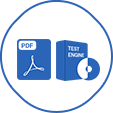Last Update 20 hours ago Total Questions : 55
The Oracle Utilities Customer to Meter and Customer Cloud Service 2025 Implementation Professional content is now fully updated, with all current exam questions added 20 hours ago. Deciding to include 1z0-1196-25 practice exam questions in your study plan goes far beyond basic test preparation.
You'll find that our 1z0-1196-25 exam questions frequently feature detailed scenarios and practical problem-solving exercises that directly mirror industry challenges. Engaging with these 1z0-1196-25 sample sets allows you to effectively manage your time and pace yourself, giving you the ability to finish any Oracle Utilities Customer to Meter and Customer Cloud Service 2025 Implementation Professional practice test comfortably within the allotted time.
There are various searching capabilities that a business user can use to locate customer and device-related information. What can be used to find devices, measuring components, service points, or usage subscriptions using a variety of search criteria?
A Rate Schedule contains the calculation rules that perform specific types of calculations. Which three options are controlled by a Rate Schedule’s configuration?
What determines an account's balance?
How many frozen bill segments are on a bill for a customer with one or more payment arrangements?
In which plug-in spot can an implementation configure an algorithm to delete a bill as part of the bill completion process?
A customer is regularly billed for consumption charges. What must exist before a customer’s usage can be calculated for billing purposes?
In Customer to Meter, which application component captures the source record that contains information on where an asset/device is installed?

